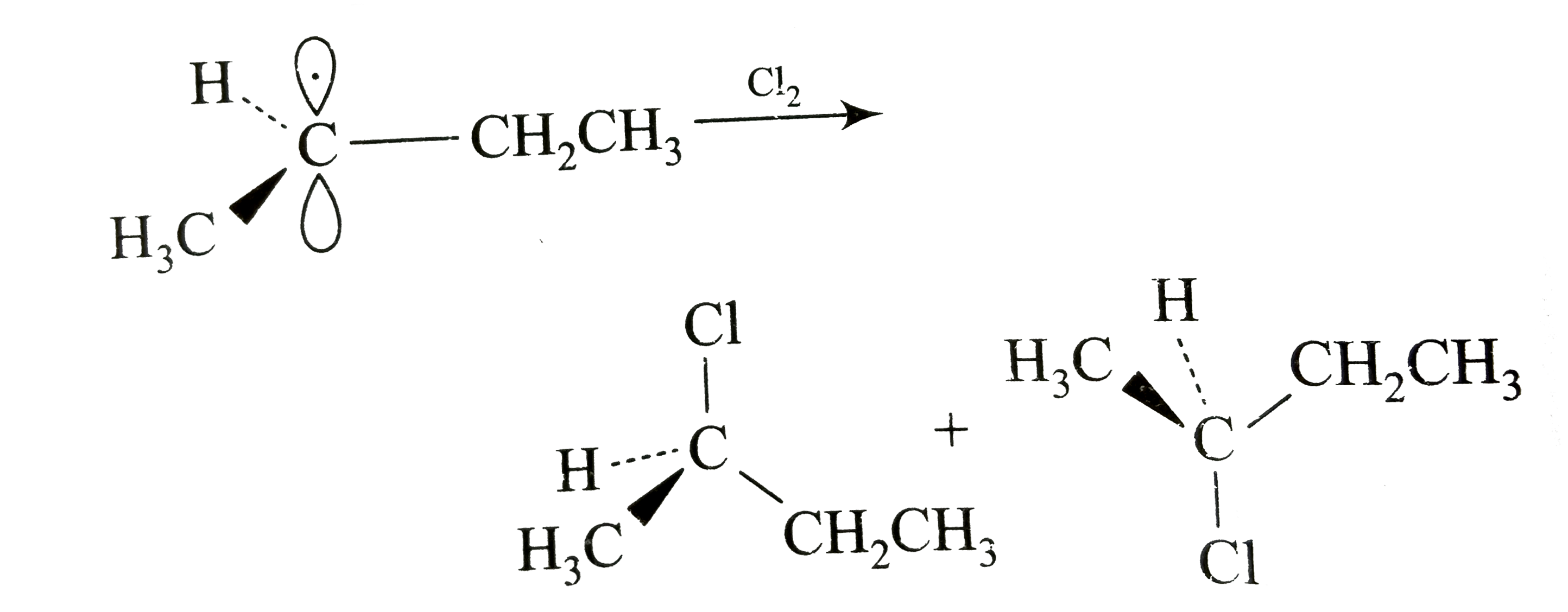What is the sterostructure of the monochlobutanes obtained form the free radical chlorination of butane?
(i) (+)−2−Chlorbutane
(ii) (−)−2−Chlorobutane
(ii) (±)−2−Chlorobutane
(iv) Achiral−1−Chlorobutane
A
(i),(ii),(iii),(iv)
B
(i),(iv)
C
(ii),(iv)
D
(iii),(iv)
Video Solution
Text Solution
The correct Answer is:D
The two products are achiral 1−chlorobutane and racemic 2−chlorobutane:
CH3CH2CH2CH3CI2−−→hvCH3CH2CH2CH2CI+CH31−Chlorobutane(achiral)CHCH2CH3∣CI2−Chlorobutane(racemic mixture)
The intermediate from the first propagation step is the radical CH3CHCH2CH3(for 2−"chlorobutane"). The radical C is sp2 hybridized and its three bonds are coplanar, with the odd electron in a p-orbital at right angles to this plane. In the second propagation step, the radical can remove a CI atom form CI2 on either side of the plane to given one product that is R and the other S. These attacks occur with equal probability, resulting in equal amounts of R and S (i.e. a racemic form).

The flat radical is said to have enantiotopic faces beacuse bonding of a fourth ligand to one or the other face gives one or the other enantiomer.
Nite that racemic 2−chlorobutane would also be obtained if the sec-buty radical were not flat but pyramidal beacuse abstraction of either 2∘ hydrogen is equally likely, giving equal amounts of enantiomeric pyramidal radicals, each of which reacts equally radialy with chlorine, thus giving equal amounts of enantiomeric sec-BuCI molecules (i.e. the racemic mdification). Moreover, a pyramidal radical undergoes rapid inversion and lose configuration.
|
Topper's Solved these Questions
- STEREOCHEMISTRYBook:R SHARMAChapter:STEREOCHEMISTRYExercise:Follow-up Test 2
Explore 1 Video
- STEREOCHEMISTRYBook:R SHARMAChapter:STEREOCHEMISTRYExercise:Follow-up Test 3
Explore 1 Video
- STEREOCHEMISTRYBook:R SHARMAChapter:STEREOCHEMISTRYExercise:Follow-up Test 1
Explore 1 Video
- SOLUTIONSBook:R SHARMAChapter:SOLUTIONSExercise:ARCHIVES
Explore 42 Videos
- SURFACE CHEMISTRYBook:R SHARMAChapter:SURFACE CHEMISTRYExercise:Archives
Explore 18 Videos
Similar Questions
Knowledge Check
2-chlorobutane obtained by chlorination of butane will be .
Ameso -formBd-formCrecemic formDl-formMonochlorination of (S)-2-chlorobutane can give:
A(S)-1,2-dichlorobutanceB(R)−1,2−dichlorobutaneC(2R,3S)-2,3-dichlorobutaneD(2R,3R)-2,3-dichlorobutaneAmong the isomers of C5H11Cl, the one which is chiral is
(i) 2,2-Dimethy-1-chloropropane
(ii) 2-Chloropentane
(iii) 2-Methyl-2-chlorobutane
(iv) 3-ChloropentaneA(i) and (ii) onlyB(i),(ii) and (iii) onlyC(i) and (iii) onlyD(ii) only
Write the equations for the preparation of 1- iodobutane from
(i) 1- butanol (ii) 1-chlorobutane (iii) but -1-ene.
View SolutionDraw and name all monochloro products you would expect to obtain from free radical chlorination of 2-methyl pentane.
View SolutionExplain optical activity of 2-chlorobutane
View SolutionPure (+)2- chlorobutane gives how many different dichlorbutanes?
View SolutionWhich of the following compounds will give a mixture of 1 - chlorobutane & 2 - chlorobutane on free radical chlorination ?
View Solution

